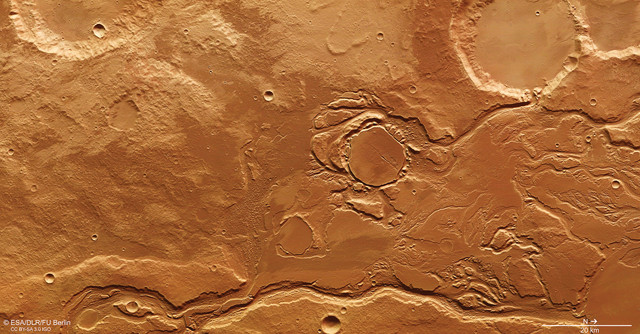
by Robin Wylie Monday, June 19, 2017

Part of Mangala Valles runs across the bottom of this image, which was taken with the High Resolution Stereo Camera aboard Mars Express in July 2015. (Note that north is to the right in the image.) Credit: ESA/DLR/FU Berlin, CC BY-SA 3.0 IGO.
A complex system of river-like channels on Mars widely thought to have been formed by flowing water could instead have been carved by a huge lava flow, according to a new study. The findings could affect our understanding of how supportive Mars might have been for life in the past.
The channel system, known as Mangala Valles, stretches longitudinally for approximately 1,000 kilometers near the Martian equator. It is one of about 150 similar “outflow channels” on Mars whose morphologies resemble fluvially carved features on Earth. Most Mars researchers have attributed Mangala Valles’ formation to one or more releases of colossal floodwaters from aquifers several billion years ago. But the new research, published in the Journal of Volcanology and Geothermal Research, suggests that the channels were formed by an outpouring of lava from a nearby volcano, Arsia Mons.
Giovanni Leone, a planetary scientist at ETH Zurich in Switzerland, analyzed more than 200 high-resolution photographs of Mangala Valles recently taken by the Mars Reconnaissance Orbiter, as well as data collected by the Mars Orbiter Laser Altimeter aboard the Mars Global Surveyor between 1997 and 2006. In the images, he identified geomorphological features that he says argue against a fluvial origin for the channels.
One of these features is a distinctive basalt ridge, roughly 60 kilometers wide and 4 kilometers high, which runs for 400 kilometers or so along the eastern side of Mangala Valles. Such a feature is unlikely to be carved by water, he says. “Water does not form basaltic ridges even on Earth, only tectonic processes do,” Leone says. “Given that plate tectonics is absent on Mars, only lava flows could have built these ridges.” Similar ridges are observed in lava fields in other parts of Mars.
Another line of evidence refuting a watery origin is the lack of geological signatures of lava-ice interactions in the vicinity of Mangala Valles, he says. If large quantities of water once flowed through Mangala Valles, Leone says, it should have left remnant ice in the pores of surface rocks there. Most Mars scientists agree that lava did eventually flow through Mangala Valles sometime after its initial formation, which means that the channels should show signs — like maars and rootless cones — of the violent steam eruptions that occur when lava and ice meet. Such signs have previously been observed at another channel system on Mars, Athabasca Valles, but Leone found no such evidence at Mangala Valles.
Leone also cites support for his idea from altimetry data. According to the prevailing theory, the groundwater that is supposed to have carved Mangala Valles was released from deep aquifers when a subsurface magmatic intrusion caused extensive fracturing in the vicinity of Mangala Fossa — a feature commonly interpreted as a section of down-dropped, fault-bounded crust called a graben — near the head of the channel system. This intrusion would likely have deposited significant quantities of lava along the sides of Mangala Fossa, thereby creating elevated topography, but altimetry shows that the terrain around Mangala Fossa is relatively smooth and inconsistent with a large emplacement of magma, Leone says.
In his interpretation, Mangala Fossa isn’t a graben but is instead the remnant of a lava tube extending from Arsia Mons, and Mangala Valles was likely formed when lava broke out of the original lava tube and carved new channels. If he’s right, the eruption responsible must have been exceptionally large: at least 180,000 cubic kilometers of lava, in his estimation, based on the combined volume of the channels.
“This paper appropriately brings into question the very notion that water once flowed through this and other Martian outflow systems,” says David Leverington, a planetary scientist at Texas Tech University who was not involved in the study. “This issue is of central importance for our understanding of Mars,” he says.
Other recent studies have also questioned fluvial formation mechanisms for other outflow channels, such as Hrad Vallis and Athabasca Valles. “Aqueous interpretations of the Martian outflow channels have implied the past existence of long-lived aquifers and the periodic development of seas or oceans, environments that might have been supportive of the development of life,” Leverington says. “A volcanic origin for these channels would lessen the likelihood that such aqueous environments were widespread.”
But many researchers do not share the volcanic interpretation. The idea fails to explain how certain morphologic features observed on the floor of Mangala could be the result of lava erosion, says Jeffrey Plescia, a planetary geologist at Johns Hopkins University. “Striations along the floor, teardrop-shaped islands, and jumbled terrain on the margins have all been explained in the context of fluvial processes,” Plescia says.
The origins of Mars’ outflow channels are more than a geologic curiosity for scientists; they could have major implications for human exploration of the Red Planet, including the search for life. Because outflow channels are linked to the presence of water and potentially life, they are high on the list of potential landing sites for future Mars rovers; for example, the European Space Agency has selected Mawrth Valles, an outflow channel in Mars’ northern hemisphere, as one of two candidate landing sites for its ExoMars Rover, to be launched in 2020.
© 2008-2021. All rights reserved. Any copying, redistribution or retransmission of any of the contents of this service without the expressed written permission of the American Geosciences Institute is expressly prohibited. Click here for all copyright requests.